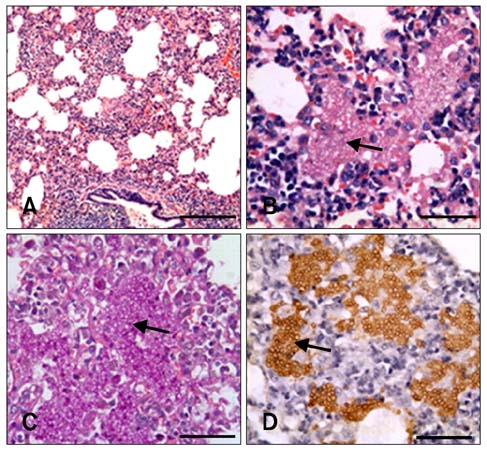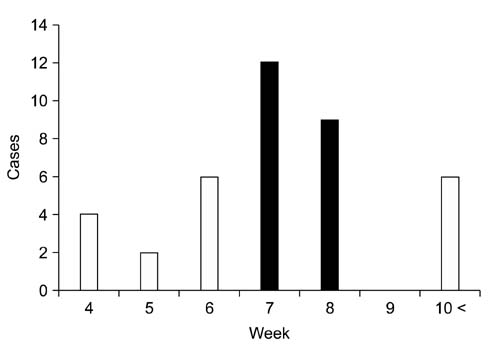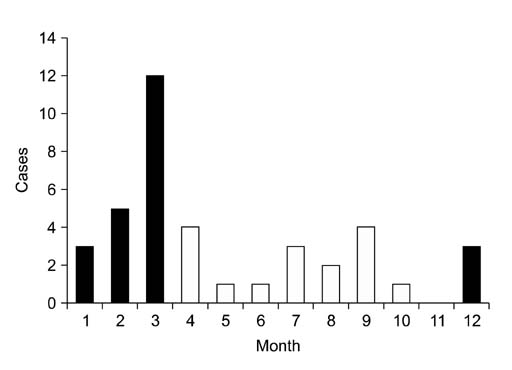J Vet Sci.
2011 Mar;12(1):15-19. 10.4142/jvs.2011.12.1.15.
Epidemiological characteristics of pulmonary pneumocystosis and concurrent infections in pigs in Jeju Island, Korea
- Affiliations
-
- 1College of Veterinary Medicine and Veterinary Medical Research Institute, Jeju National University, Jeju 690-756, Korea. kimjhoon@jejunu.ac.kr
- 2College of Life Science and Natural Resources, Sangji University, Wonju 220-702, Korea.
- 3College of Veterinary Medicine, Seoul National University, Seoul 151-742, Korea.
- KMID: 1067332
- DOI: http://doi.org/10.4142/jvs.2011.12.1.15
Abstract
- Epidemiological characteristics of swine pulmonary Pneumocystis (P.) carinii and concurrent infections were surveyed on Jeju Island, Korea, within a designated period in 172 pigs submitted from 54 farms to the Department of Veterinary Medicine, Jeju National University. The submitted cases were evaluated by histopathology, immunohistochemistry, PCR/RT-PCR, and bacteriology. P. carinii infection was confirmed in 39 (22.7%) of the 172 pigs. Histopathologically, the lungs had moderate to severe lymphohistioctyic interstitial pneumonia with variable numbers of fungal organisms within lesions. Furthermore, porcine reproductive and respiratory syndrome virus (PRRSV) and porcine circovirus type 2 (PCV-2) co-infection was a common phenomenon (12.8%, 20.5%, and 48.7% were positive for PRRS, PCV-2, or both, respectively, as determined by PCR/RT-PCR). Infection was much more concentrated during winter (December to March) and 53.8% of the infected pigs were 7- to 8-weeks old. In addition, three pigs showed co-infection with bacteria such as Pasteurella multocida and Streptococcus suis. The results of the present study suggest that the secondary P. carinii infection is common following primary viral infection in swine in Korea. They further suggest that co-infection of P. carinii might be enhanced by the virulence of primary pathogens or might have synergistic effects in the pigs with chronic wasting diseases.
Keyword
MeSH Terms
-
Aging
Animals
*Circovirus/pathogenicity
Incidence
Pasteurella Infections/complications/epidemiology/veterinary
Pasteurella multocida/i
*Pneumocystis carinii/immunology/pathogenicity
Pneumonia, Pneumocystis/complications/epidemiology/physiopathology/*veterinary
Porcine Postweaning Multisystemic Wasting Syndrome/complications/*epidemiology
Porcine Reproductive and Respiratory Syndrome/*epidemiology
*Porcine respiratory and reproductive syndrome virus/pathogenicity
Prevalence
Republic of Korea/epidemiology
Reverse Transcriptase Polymerase Chain Reaction
Sea
Streptococcal Infections/complications/epidemiology/veterinary
Streptococcus suis/i
Sus scrofa
Swine Diseases/epidemiology/virology
Figure
Reference
-
1. Bille-Hansen V, Jorsal SE, Henriksen SA, Settnes OP. Pneumocystis carinii pneumonia in Danish piglets. Vet Rec. 1990. 127:407–408.2. Cavallini Sanches EM, Borba MR, Spanamberg A, Pescador C, Corbellini LG, Ravazzolo AP, Driemeier D, Ferreiro L. Co-infection of Pneumocystis carinii f. sp. suis and porcine circovirus-2 (PCV2) in pig lungs obtained from slaughterhouses in southern and midwestern regions of Brazil. J Eukaryot Microbiol. 2006. 53:Suppl 1. S92–S94.3. Christopher-Hennings J, Nelson EA, Nelson JK, Hines RJ, Swenson SL, Hill HT, Zimmerman JJ, Katz JB, Yaeger MJ, Chase CCL, Benfield DA. Detection of porcine reproductive and respiratory syndrome virus in boar semen by PCR. J Clin Microbiol. 1995. 33:1730–1734.
Article4. Clark EG. Post-weaning multisystemic wasting syndrome. Proc Am Assoc Swine Pract. 1997. 28:499–501.5. Ellis J, Hassard L, Clark E, Harding J, Allan G, Willson P, Strokappe J, Martin K, McNeilly F, Meehan B, Todd D, Haines D. Isolation of circovirus from lesions of pigs with postweaning multisystemic wasting syndrome. Can Vet J. 1998. 39:44–51.6. Fujita M, Furuta T, Nakajima T, Kurita F, Kaneuchi C, Ueda K, Ogata M. Prevalence of Pneumocystis carinii in slaughtered pigs. Nippon Juigaku Zasshi. 1989. 51:200–202.7. Jung JY, Kim KS, Kim DY, Kim JH. Pneumocystis carinii pneumonia in pigs. Korean J Vet Res. 2007. 47:321–324.8. Kondo H, Hikita M, Ito M, Kadota K. Immunohistochemical study of Pneumocystis carinii infection in pigs: evaluation of Pneumocystis pneumonia and a retrospective investigation. Vet Rec. 2000. 147:544–549.
Article9. Kondo H, Kuramochi T, Taguchi M, Ito M. Serological studies on porcine Pneumocystis carinii pneumonia: kinetics of the antibody titers in swine herds and the association of porcine reproductive and respiratory syndrome virus infection. J Vet Med Sci. 1997. 59:1161–1163.
Article10. Kondo H, Taguchi M, Abe N, Nogami Y, Yoshioka H, Ito M. Pathological changes in epidemic porcine Pneumocystis carinii pneumonia. J Comp Pathol. 1993. 108:261–268.
Article11. Kucera K, Slesinger L, Kadlec A. Pneumocystosis in pigs. Folia Parasitol (Praha). 1968. 15:75–78.12. Larochelle R, Antaya M, Morin M, Magar R. Typing of porcine circovirus in clinical specimens by multiplex PCR. J Virol Methods. 1999. 80:69–75.
Article13. Lu JJ, Lee CH. Pneumocystis pneumonia. J Formos Med Assoc. 2008. 107:830–842.
Article14. Lubis N, Baylis D, Short A, Stebbing J, Teague A, Portsmouth S, Bower M, Nelson M, Gazzard B. Prospective cohort study showing changes in the monthly incidence of Pneumocystis carinii pneumonia. Postgrad Med J. 2003. 79:164–166.
Article15. Nielsen J, Bille-Hansen V, Settnes OP. Experimental corticosteroid induction of Pneumocystis carinii pneumonia in piglets. APMIS. 1999. 107:921–928.
Article16. Park SY, Lee HK. Combined Pneumocystis carinii pneumonia and miliary tuberculosis in a patient with AIDS. Korean J Pathol. 1994. 28:657–662.17. Segalés J, Domingo M, Chianini F, Majó N, Domínguez J, Darwich L, Mateu E. Immunosuppression in postweaning multisystemic wasting syndrome affected pigs. Vet Microbiol. 2004. 98:151–158.
Article18. Settnes OP, Henriksen SA. Pneumocystis carinii in large domestic animals in Denmark. A preliminary report. Acta Vet Scand. 1989. 30:437–440.
Article19. Shimizu M, Yamada S, Kawashima K, Ohashi S, Shimizu S, Ogawa T. Changes of lymphocyte subpopulations in pigs infected with porcine reproductive and respiratory syndrome (PRRS) virus. Vet Immunol Immunopathol. 1996. 50:19–27.
Article20. Stringer JR, Beard CB, Miller RF, Wakefield AE. A new name (Pneumocystis jiroveci) for Pneumocystis from humans. Emerg Infect Dis. 2002. 8:891–896.21. Varela JM, Regordán C, Medrano FJ, Respaldiza N, de la Horra C, Montes-Cano MA, Calderón EJ. Climatic factors and Pneumocystis jiroveci infection in southern Spain. Clin Microbiol Infect. 2004. 10:770–772.22. Wazir JF, Ansari NA. Pneumocystis carinii infection. Update and review. Arch Pathol Lab Med. 2004. 128:1023–1027.
- Full Text Links
- Actions
-
Cited
- CITED
-
- Close
- Share
- Similar articles
-
- Epidemiological Characteristics of Shigellosis in Jeju Island in 2003
- Detection of swine hepatitis E virus in the porcine hepatic lesion in Jeju Island
- Epidemiologic characteristics of scrub typhus on Jeju Island
- Prevalence of porcine parvovirus in pigs with postweaning multisystemic wasting syndrome in Jeju Island
- Pathological characteristics on porcine enteritis associated with porcine circovirus type 2 in Jeju




